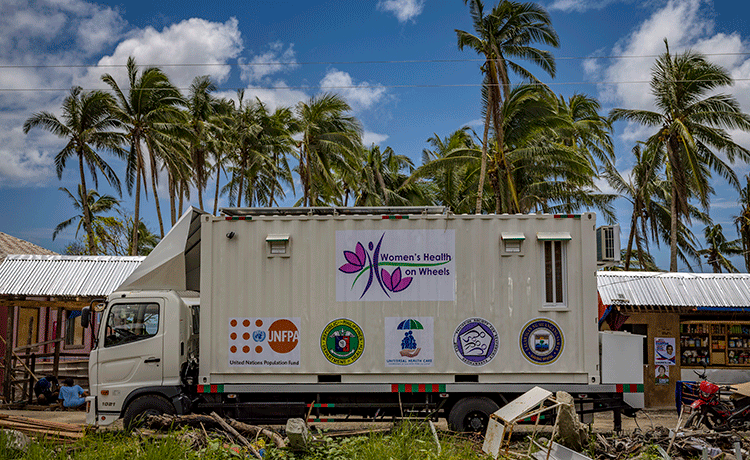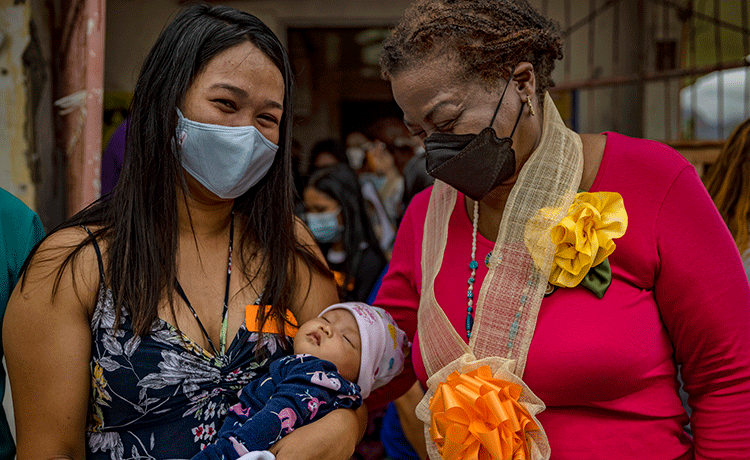News
Hope on wheels: Emergency maternal health units reach farthest corners of the Philippines
- 19 April 2022
News
SAINT BERNARD, The Philippines – “Our house was gone, we could smell petrol fuel leaking from the fishing boats, and the wind was howling. I wanted to run to the mountains with my two young children.”
Fleeing her home at seven months pregnant wasn’t what 30-year-old Mariel had planned for her family during the Christmas festivities. But as Super Typhoon Rai barrelled down on the small fishing village of Saint Bernard, in the Southern Leyte province of the Philippines, it was her only option.
The third largest storm ever to hit the northern hemisphere, Rai demolished homes across the islands, splintering trees and forcing hundreds of thousands to run for their lives. Nearly four months on, many people are still without stable housing or access to food or medical care: Most health facilities remain obliterated, others hanging on by a thread. Health staff don’t have clinics to work in, while contraceptive supplies and medical equipment are sorely lacking.
UNFPA’s Executive Director Dr. Natalia Kanem reflected after meeting with some of the women and girls affected: “A record number of people around the world are displaced and in need of humanitarian assistance. Humanitarian crises don’t just leave communities upended, they also expose women and girls to greater levels of vulnerability. Disasters and conflict worsen gender inequalities, with women and girls paying the heaviest price.”
A rolling salvation
Providing sexual and reproductive health care can be dangerously jeopardized in a crisis setting, including prenatal and antenatal services, as infrastructure is destroyed and roads become impassable. Scarce if any access to health services leads to a rise in maternal and newborn deaths, spikes in sexual violence and, as a new UNFPA report shows, soaring rates of unintended pregnancies.
Increasingly anxious about giving birth in the midst of a disaster zone, Mariel’s hopes were lifted when she spotted an unusual vehicle in town. “One day, a white truck was parked in the community, and someone told me they had health services there. I didn’t believe them, but eventually I went, and my worries were gone,” she said, relieved at the arrival of skilled health staff and new medical equipment.
The white truck is a UNFPA-supported Women’s Health on Wheels vehicle, a mobile birthing facility deployed to hard-to-reach areas and during humanitarian emergencies. The rapid response mobile units are the default set-up when basic emergency obstetric and newborn care services are disrupted. Based in the centre of Saint Bernard, the truck has become a beacon of survival and hope for many of the vulnerable women and girls in the community.

The mobile units are a key part of UNFPA’s response, which as of March 31 had reached nearly 14,000 women and girls in affected areas with sexual and reproductive health and protection services. This includes distributing dignity kits containing sanitation, menstrual and hygiene products, as well as providing emergency maternity tents and setting up safe spaces where survivors and those at risk of gender-based violence can go to seek help and support. In Southern Leyte alone, UNFPA has so far supported over 1,000 safe deliveries and ensured more than 1,700 family planning consultations.
A crisis within a crisis
Observing the devastation brought on by the storm, Dr. Kanem continued: “With the Philippines ranking as one of the countries most prone to crises – from conflict to earthquakes and typhoons – millions of the most vulnerable people, particularly women and girls, are facing multiple layers of risk.”
An estimated 400 lives were lost during the typhoon and more than half a million people displaced, of which some 60,000 have yet to return to their homes – if they still have them. Over 11 million people were affected by the storm; among them are 4 million women of reproductive age, 1.4 million adolescent girls and a quarter of a million women who are currently pregnant.
While the statistics are grim, Dr. Kanem added there is a solution – by listening to and investing in women. Their leadership and resilience bring communities together as they spearhead efforts to mitigate and adapt to climate change.
On 14 February, Mariel became the first woman to give birth in the mobile health unit. She told us she had named her new daughter Heart Eunne Fae: Heart for being born on Valentine’s day, and Eunne Fae as a tribute to UNFPA. When Dr. Kanem asked about her wish for Eunne Fae, Mariel replied: “Brighter skies, a roof over her head, and a better life than what we have now. And to live in a world where she can grow up without fear and become a girl who can bring change to our community.”
